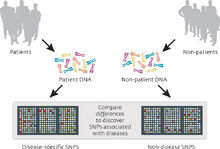Overview:

General overview of the utility of GWAS (image courtesy of Pasieka Science Photo Library)
A genome-wide association study (GWAS) compares two populations of one species--one population inflicted with a particular characteristic, like a disease, and one population devoid of this characteristic--the control group. The outcome is to identify particular genes that the target study population posessess that the "normal" control group lacks. While obesity has often be linked to lifestyle choices (environment) moreso than genetics, several genome-wide association studies have identified specific genes that are possessed by obese humans that normal-weight individual lack.
Specific GWAS Study:
While myriad genome-wide associations studies on obesity have been conducted (the largest of which was included 250,000 individuals and identified 2.8 million SNPs), this article focuses specifically on the 2011 GWAS on obesity and obesity-linked traits by Kai Wang et al for the online journal PLoS One. In this particular piece of research, 520 obese cases (BMI greater than 35) and 540 control cases (BMI less than 25), as well as 500 families classified as either "extremely thin" or "extremely overweight," were assessed for measures of obesity and obesity-related traits. The top 500 SNPs from the GWAS were genotyped from the combined sample of cases. Obesity was identified as being a binary trait as there are two specific genes that obese individuals possess that normal-weight individuals either do not at all, or do, but in reduced quantity.
For the binary trait of obesity, 16 genome-wide significant signals were found within the FTO gene (strongest signal at rs17817449), and 12 signals at the MC4R gene. The FTO gene is located on chromosome 16, and has been previously-correlated with obesity and increased food intake in rats. In fact, in a study of 38,759 Europeans for variants of FTO, carriers of one copy of the allele weighed approximately 2.6 pounds more than people with no copies, and carriers of two copies weighed 6.6 pounds more and had a 1.67-fold higher rate of obesity than those with no copies. The other significant obesity gene--MC4R-- is a G-protein coupled receptor that is known to play a role in "feeding behavior" and regulation of metabolism.
Next, the researchers examined obesity-related quantitative traits, like total body wieght, waist-to-hip ratio, and waist circumference, and found significant genome-wide signals between waist to hip ratio and the NRXN3 gene (rs11624704), which has been previously-associated with body weight and fat distribution.

Enriched disorder pathways related to the 22 genes found by GWAS as risk genes for obesity (Image via Nature)
Significant Results:
While researchers have identified upward of 16 genes that are likely associated with obesity, FTO, MC4R and NRXN3 are the only genes determined as being unique to a sizable population of obese individuals in this particular study. Among these three genes, only FTO and MC4R reached genome-wide significance--FTO with an odds ratio of 1.6 and MC4R with an odds ratio of 1.3. As stated in the PLoS One paper:
"The fact that FTO readily reached genome-wide significance in a small data set confirmed the high quality of the phenotypes within the sample collection. It also illustrated how a small sample ascertained from extreme phenotypes have high power to detect genuinely associated genes, compared to quantitative trait association analysis conducted on population-based samples...The results therefore strongly suggest that FTO and MC4R might be the only two major-effect genes for obesity with common variants in populations of European ancestry."
Thus, it makes sense that both the FTO gene and MC4R gene show genome-wide significance, as they are both associated with increased food intake and increased body mass. Studies such as this and other GWAS analyses of obesity give credence to the developing body of research that obesity is a disease that is affected by both lifestyle and genetic circumstances, and must be treated with a more scientific approach.
References:
Brols, Nils. "GWAS, Modern Psychiatry," 2010. Max Planck Institute for Experimental Medicine.
Frayling TM, Timpson NJ, Weedon MN, Zeggini E, Freathy RM, Lindgren CM, Perry JR, Elliott KS, Lango H, Rayner NW, Shields B, Harries LW, Barrett JC, Ellard S, Groves CJ, Knight B, Patch AM, Ness AR, Ebrahim S, Lawlor DA, Ring SM, Ben-Shlomo Y, Jarvelin MR, Sovio U, Bennett AJ, Melzer D, Ferrucci L, Loos RJ, Barroso I, Wareham NJ, Karpe F, Owen KR, Cardon LR, Walker M, Hitman GA, Palmer CN, Doney AS, Morris AD, Smith GD, Hattersley AT, McCarthy MI (2007). "A common variant in the FTO gene is associated with body mass index and predisposes to childhood and adult obesity".Science 316 (5826): 889–94. Bibcode:2007Sci...316..889F.doi:10.1126/science.1141634. PMC 2646098. PMID 17434869.http://www.ncbi.nlm.nih.gov/pmc/articles/PMC2646098/
Wang, Kai. "A Genome-Wide Association Study on Obesity and Obesity-Related Traits." PLoS One. 2011; 6(4): e18939. Published online Apr 28, 2011. doi: 10.1371/journal.pone.0018939